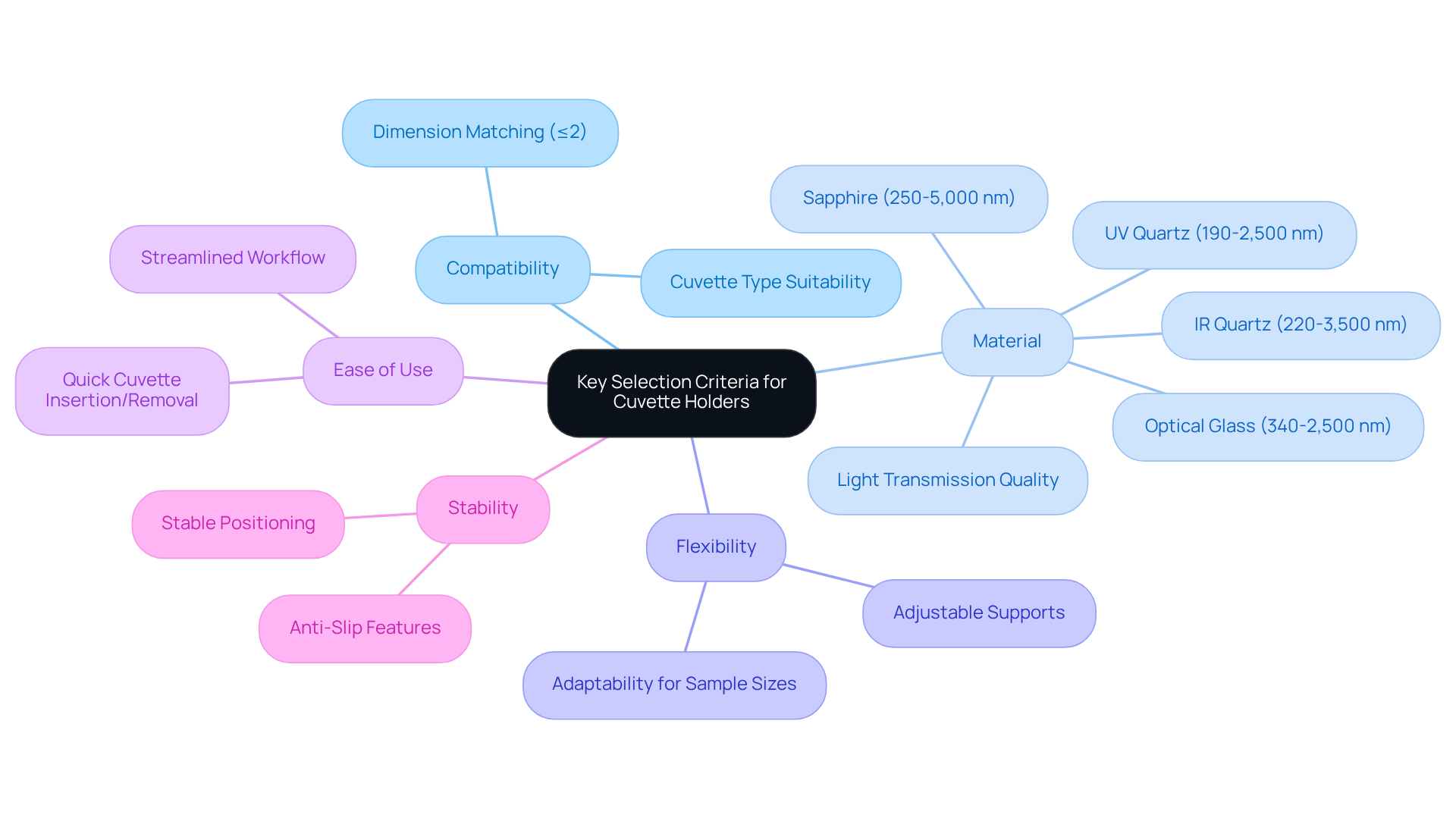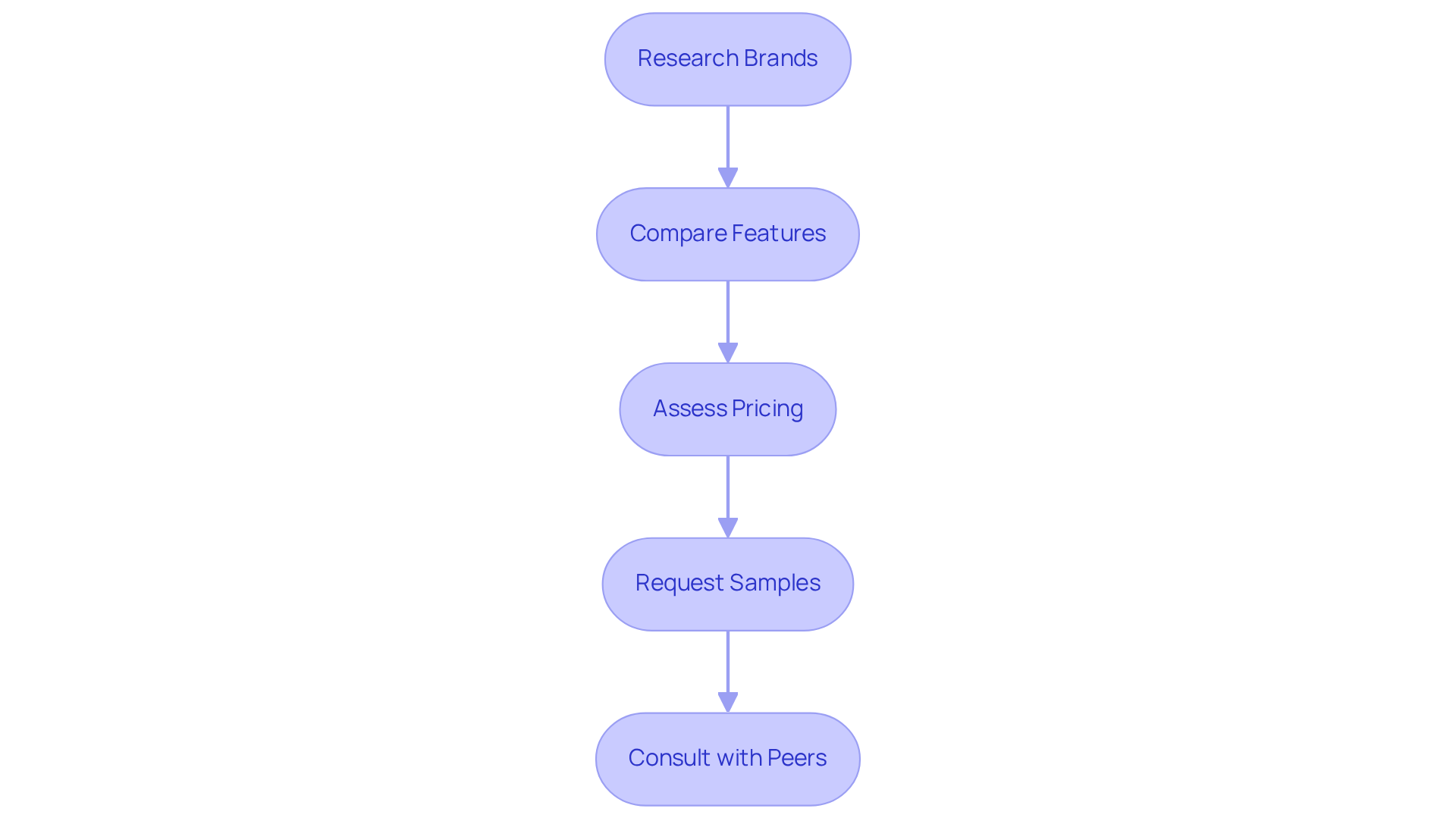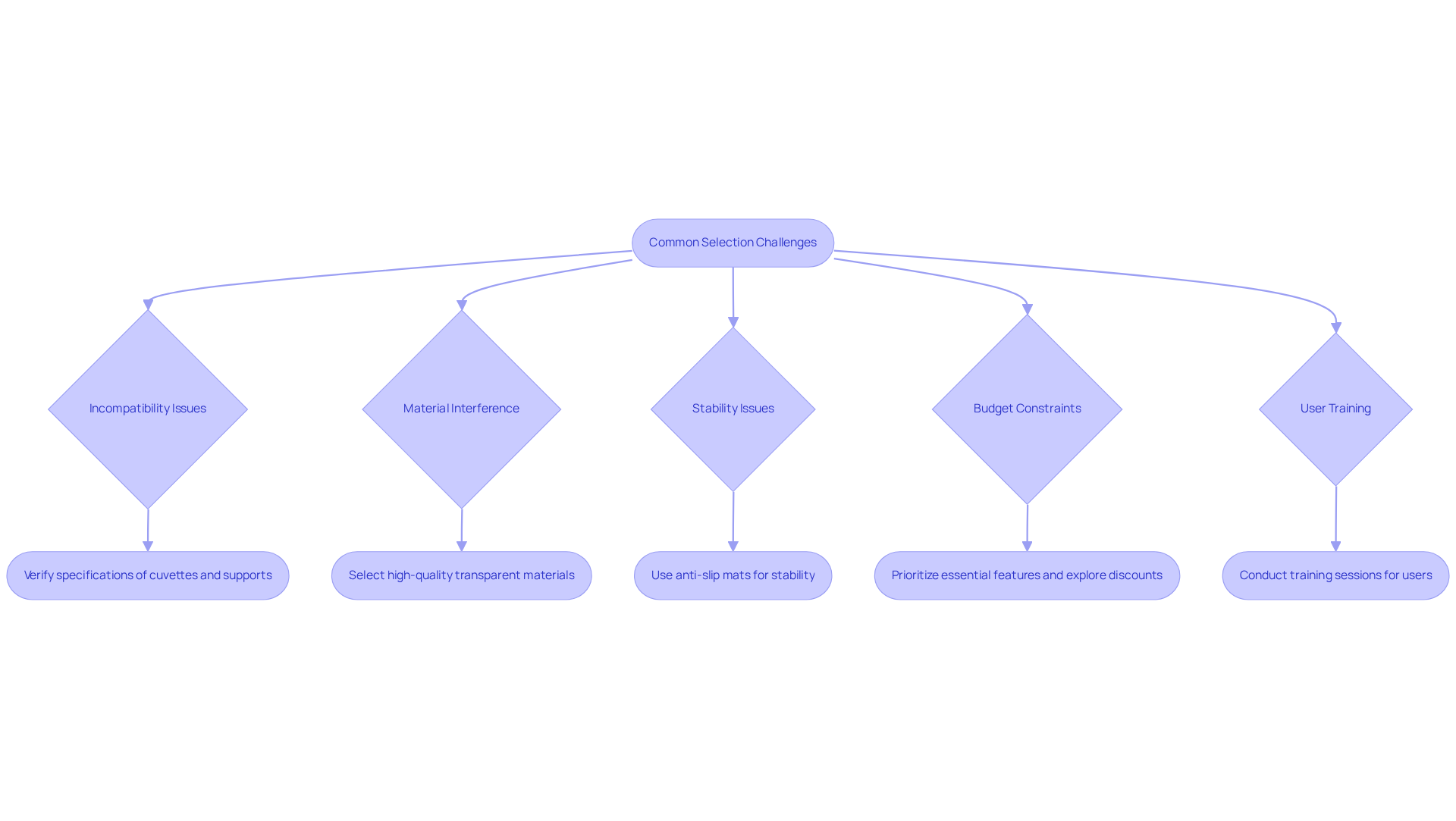Overview
The article primarily addresses the critical process of selecting cuvette holders for pharmaceutical laboratories, emphasizing the necessity for optimal performance in spectrophotometric analysis. It is imperative to consider various factors, including:
- Compatibility
- Material quality
- Flexibility
- Ease of use
- Stability
as these elements directly impact the accuracy and reliability of analytical results within a laboratory environment. By understanding the significance of these criteria, laboratory professionals can make informed decisions that enhance their analytical capabilities. Therefore, meticulous attention to these details is not merely advisable but essential for achieving superior outcomes in laboratory analyses.
Introduction
Selecting the right cuvette holder is paramount for achieving accurate and reliable results in pharmaceutical laboratories, where precision is critical. This guide explores the essential criteria for choosing cuvette holders, providing insights into their various types and the significant impact they have on spectrophotometric analysis.
With numerous options available and potential challenges—such as compatibility issues and material interference—laboratories must navigate these complexities to ensure they make the best choice for their specific needs.
Understand Cuvette Holders and Their Importance
are indispensable components in spectrophotometric analysis, as they provide a stable and secure environment for cuvettes that house samples for measurement. Their critical role lies in ensuring consistent light path alignment, thereby minimizing errors during analysis.
In pharmaceutical laboratories, where precision is paramount, the selection of the appropriate sample container significantly influences the accuracy and reproducibility of results. Understanding the various types of sample containers available—such as fixed, adjustable, and multi-sample containers—is essential for selecting the most suitable option for specific applications. This foundational knowledge not only informs the selection process but also sets the stage for achieving .

Identify Key Selection Criteria for Cuvette Holders
When selecting a cuvette holder, several must be taken into account to ensure optimal performance in pharmaceutical labs.
- Compatibility is paramount. Verify that the support is suitable for the cuvette types you intend to use, paying close attention to dimensions and materials, whether glass or plastic. Matched cuvettes should vary by no more than 2% to achieve optimal repeatability, making this attention to compatibility crucial for avoiding disruptions in workflows and ensuring accurate measurements.
- Next, consider the Material. Choose supports made from substances that reduce interference with light transmission, such as quartz or high-quality plastics. For instance, UV Quartz cuvettes offer an extended transmission range of 190-2,500 nm, making them essential for UV experiments. The selection of material can greatly influence the quality of the data gathered, rendering it an essential factor in selecting a container.
- Flexibility is another important aspect. Think about adaptable supports if you need to fit different sample sizes or require exact alignment for particular measurements. Pharmaceutical facilities have refined their processes by employing adjustable supports that enable swift modifications to various experimental arrangements, thus improving overall efficiency.
- Consider the Ease of Use as well. Choose a cuvette holder that enables quick and easy cuvette insertion and removal. This feature is particularly beneficial in busy labs, where time efficiency is paramount and can significantly streamline workflow processes.
- Finally, ensure Stability. A reliable support is essential for ensuring consistent evaluations, particularly during prolonged analysis durations. Search for supports with anti-slip characteristics or those intended for stable positioning on lab benches to guarantee dependability in your results.
By carefully evaluating these criteria, pharmaceutical labs can optimize their workflow and enhance the accuracy of their analytical measurements. Integrating expert perspectives, like those from FireflySci, can further assist in the selection process, ensuring that the selected containers fulfill the specific requirements of laboratory operations.

Evaluate Available Cuvette Holder Options
To effectively evaluate the available cuvette holder options for your pharmaceutical lab, follow these essential steps:
- Research Brands: Start by identifying reputable brands known for their high-quality laboratory equipment. User reviews and testimonials provide valuable insights into the reliability and performance of various sample containers. Notable products, such as the DeNovix DS-C Cuvette Spectrophotometer, are engineered for , positioning them as strong contenders in your selection process.
- Compare Features: Develop a comparison chart that highlights the characteristics of different sample containers. Key aspects to consider for a cuvette holder include material composition, adjustability, compatibility with your specific spectrophotometer model, secure positioning mechanisms, alignment guides, and easy-to-clean surfaces. Some supports are designed for flow-through applications, enhancing their versatility in experiments.
- Assess Pricing: While budget considerations are important, prioritize quality and reliability over the lowest price. Investing in a robust sample container can prevent future complications and ensure consistent results in your analyses. Additionally, consider the warranty offered; for example, the DS-C instruments come with a three-year factory warranty, adding to their reliability.
- Request Samples: If feasible, request samples or demonstrations from suppliers. This practical approach allows you to evaluate the performance of the devices in your lab setting, ensuring they meet your specific requirements.
- Consult with Peers: Engage with colleagues or participate in industry forums to gather insights based on their experiences with different sample containers. Peer feedback is invaluable in assessing performance, durability, and overall satisfaction with various products. JM Science has received positive feedback from healthcare professionals for its innovative products, which can guide your decision-making process.
By following these steps, you can make an informed choice when selecting containers that best align with the needs of your pharmaceutical laboratory.

Troubleshoot Common Selection Challenges
Choosing the appropriate sample containers presents several challenges for pharmaceutical laboratories. Understanding these challenges is essential for ensuring accurate results and operational efficiency. Here are some common issues and their solutions:
- Incompatibility issues often arise when the cuvette holder does not fit the cuvettes. To mitigate this, verify the specifications of both the support and the cuvettes. Consider using adjustable supports that can accommodate various sizes. Notably, 90% of customers opt for either a standard 10 mm cuvette or another type of rectangular cell, making it crucial to ensure compatibility with these prevalent options.
- Material Interference: Discrepancies in measurement results can occur due to the support material absorbing or scattering light. It is vital to select supports made from high-quality, transparent materials that do not interfere with the wavelengths being measured. This consideration is particularly important in light of ongoing supply chain challenges that may impact the availability of suitable materials.
- Stability Issues: An unstable support can lead to inaccurate readings. To enhance stability, employ anti-slip mats or select supports specifically designed for improved stability during operation. Ensuring stability is critical, as improper handling can result in significant measurement errors.
- Budget Constraints: Financial limitations can influence equipment selection. Prioritize essential features and explore options from reputable suppliers who may offer discounts for bulk purchases, ensuring you obtain the best value without compromising quality. Be aware that pricing may fluctuate due to tariffs affecting imported products, which could impact your purchasing decisions.
- User Training: If users encounter difficulties operating the device, conducting training sessions is beneficial. This ensures that all personnel are familiar with the device's features and best practices, ultimately leading to . As Derek Guenther, a Senior Application Scientist, emphasizes, proper technique is crucial for achieving optimal results in absorbance measurements.
By addressing these challenges and incorporating relevant statistics and expert insights, pharmaceutical labs can make informed decisions when choosing cuvette holders.

Conclusion
Selecting the right cuvette holder is crucial for ensuring precise and reliable results in pharmaceutical laboratories. The significance of these components cannot be overstated; they play a vital role in maintaining the integrity of spectrophotometric measurements. By understanding the various types of cuvette holders and their specific applications, laboratories can make informed decisions that enhance their analytical capabilities.
Several key points emerge regarding the selection of cuvette holders:
- Compatibility with cuvette types
- The material used
- Flexibility
- Ease of use
- Stability
Evaluating available options through brand research, feature comparison, and peer consultation can significantly streamline the selection process. Furthermore, addressing common challenges such as incompatibility, material interference, and stability issues ensures that laboratories optimize their workflow and maintain accuracy in their analyses.
In conclusion, the selection of cuvette holders is a foundational step in achieving high-quality results in pharmaceutical labs. By prioritizing the right features and overcoming potential challenges, laboratories can enhance their operational efficiency and analytical precision. As the landscape of pharmaceutical research evolves, staying informed about the latest advancements and best practices in cuvette holder selection empowers labs to meet the demands of modern scientific inquiry.




